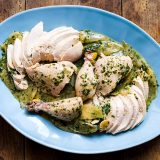A dozen years ago I had lunch at Chez l'Ami Louis, then billed as the best bistro in Paris. Twelve tables in a narrow postage stamp of a space, smoky, leather-covered walls and an old coal stove for atmosphere, not heat. This was going to be an exceptional culinary experience.
And it was, if price is one’s gauge and volume. The asparagus alone was enough to feed six. The two iPhone Plus-size slabs of foie gras would have kept Bob Cratchit's whole family satisfied. And our waiter was enjoying every tourist-fleecing moment of our meal.
But the story had a happy ending. I ordered the chicken en cocotte, a moist, delicious whole chicken roasted in a small oval Dutch oven (the cocotte), surrounded by rich, dark juices. It was a culinary triumph.
That experience led me to a simple question. Why had I spent my culinary career trying to find the perfect recipe for roast chicken, the type that is roasted naked in an oven where the radiant heat dries out the meat? The natural laws of physics force one to flip the bird, switch up oven temperatures, spatchcock it, bard it (drape it with fat), baste it, or do a thousand other silly things. Why not just cook a whole bird in a small cocotte?
The obvious reason is the skin. Americans are obsessive about crisp skin; the French aren’t. But if one can make that small sacrifice, one gains a moist easy-to-cook bird that makes its own sauce. I was all in.
Like an American-trained cook, however, pale skin was still an issue. I noted that Julia Child suggested that the bird be well-browned in butter before roasting. When we went down this road, the skin still turned soggy and less than appetizing. So why bother with this extra step? We were doing to discard the skin after cooking anyway.
I also noted that, despite the recipe name, this preparation was not limited to France. I recently interviewed Olia Hercules, author of “Kaukasis,” and she told me that in Georgia and Azerbaijan, a chicken is coated with a spiced bitter plum paste, then thrown into a small Dutch oven and roasted.
Back at Milk Street, the testing was simple enough. We found that roasting the bird breast side down was best; the white meat came out moister. Some recipes call for a screaming hot oven, but 400°F did the trick without the risk of overcooking. The other ingredients, the ones used to make the sauce, were classic: onion, garlic and white wine. After roasting, we finished the defatted juices with Dijon mustard, butter, tarragon and lemon juice.
This recipe is one of those foundation recipes—you can improvise to your heart’s content. The variation below uses dried apricots and shallots. I often brush a chicken with tamarind paste before roasting to good effect. Diane Unger, our director of recipe development, also finds that prunes work well, giving the sauce body and depth. And, of course, you can play with other coatings: za’atar, smoked paparika, pomegranate molasses and harissa all offer an easy change of pace.
The beauty of this recipe is that with almost no prep, you can throw a chicken in a pot and an hour later come back to find a perfectly roasted moist bird every time. The rest is up to you.




